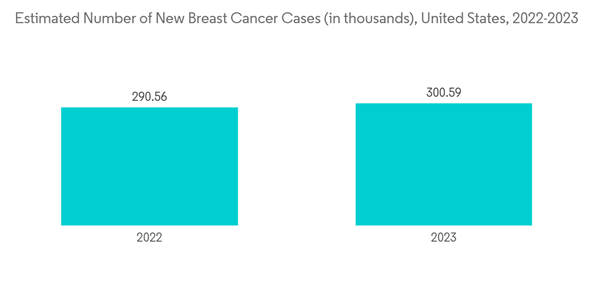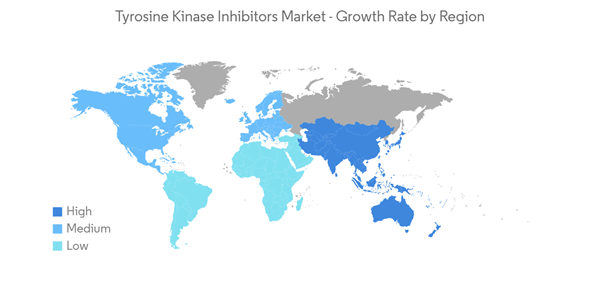The COVID-19 pandemic affected healthcare systems around the world and resulted in the interruption of usual care in many healthcare facilities, exposing vulnerable patients with cancer to significant risks during the early pandemic phase. However, as the pandemic progressed tyrosine kinase inhibitor drugs started to show promising results in COVID-19 patients and there was an increased number of clinical trials. For instance, according to an article published by Frontiers in April 2022, imatinib, a tyrosine kinase inhibitor drug, successfully inhibited cellular tyrosine kinase as well as viral fusion, blocking the COVID-19 virus replication. The source also stated that there were three clinical trials that were underway in different parts of the world to investigate the clinical efficacy of imatinib on COVID-19 patients. Thus, the pandemic had a significant impact on the market growth, however as the pandemic has subsided currently, the studied market is expected to have stable growth during the forecast period of the study.
Factors such as the increasing prevalence of cancer, growing research activities, and investment in tyrosine kinase inhibitors are expected to enhance market growth.
The rising prevalence of cancer is a major factor driving the market growth. For instance, as per the report published by the Chinese Medical Journal in March 2022, China is experiencing a greater incidence of cancers. In 2022, ithere were approximately 4,820,000 new cancer cases in China, in which the most common is lung cancer.
Moreover, according to the data published by National Cancer Center Japan in June 2022, an estimated 1,019,000 new cases of cancer were expected in Japan in 2022, out of which 158,200 were new cases of colon/rectum cancer, 132,100 cases of stomach cancer, 128,800 cases of lung/trachea cancer, 96,400 cases of prostate cancer, and 95,000 cases of breast cancer. Thus, the greater incidence of cancers has increased the demand for various tyrosine kinase inhibitor drugs for the treatment of cancers.
Furthermore, the growing research and development activities for tyrosine kinase inhibitors are also expected to boost the market growth. For instance, in August 2022, Theseus Pharmaceuticals, Inc. announced business and pipeline highlights that were focussed on developing next-generation tyrosine kinase inhibitors (TKIs) to outsmart cancer resistance. The company invested USD 7.3 million in the second quarter of 2022, as compared to USD 4.5 million for the same period in 2021. Thus, the growing research activities along with the increasing investments in tyrosine kinase inhibitors are expected to enhance the market growth.
Additionally, the rising developments by major market players are also expected to enhance market growth. For instance, in March 2021, Pfizer Inc. received United states FDA approval for a supplemental New Drug Application (sNDA) for LORBRENA (lorlatinib), a tyrosine kinase inhibitor, expanding the indication to include first-line treatment of people with anaplastic lymphoma kinase (ALK)-positive non-small cell lung cancer (NSCLC). LORBRENA is indicated for adults with metastatic NSCLC whose tumors are ALK-positive as detected by an FDA-approved test.
Thus, the aforementioned factors such as the rising prevalence of cancer, increasing research and development for novel tyrosine kinase inhibitor drugs, and the rising developments by key market players are expected to enhance the market growth. However, the high cost of therapy is expected to hinder market growth.
Tyrosine Kinase Inhibitors Market Trends
Breast Cancer Segment is Expected to Hold a Significant Market Share Over the Forecast Period
Breast cancer is a disease in which cells in the breast grow out of control. The tyrosine kinase inhibitor drugs help in blocking abnormal signal transduction pathways necessary for cell proliferation and growth in breast cancer. Factors such as the rising prevalence of breast cancer and the increasing developments by key market players are expected to enhance the market growth.For instance, according to the data updated by Cancer Australia in January 2023, it is estimated 20,640 new cases of cancer will be diagnosed in Australia during 2022 which will account for 12.7% of the new cancer cases diagnosed in the country. The source also stated that breast cancer will be the second most commonly diagnosed cancer in 2022 in Australia. Thus, the high prevalence of breast cancer is expected to boost segment growth.
Furthermore, according to the bi-annual report published by the Indian Council of Medical Research (ICMR) in December 2022, the national average of cancer cases for 2022 in India was 100.4 per 100,000, with a large number of women (an estimated 105.4 per 100,000) being diagnosed with breast cancer. The source also stated an estimated 182,000 people are living with breast cancer in India and this is expected to reach 250,000 by 2030. Thus, due to the high burden of breast cancer, the demand for tyrosine kinase inhibitor drugs is expected to increase which will drive the growth of the studied market.
Additionally, the rising developments by major market players are also expected to enhance segment growth. For instance, in September 2022 Dizal reported promising safety and pharmacokinetic data from the global phase I study of DZD1516 in patients with HER2 positive metastatic breast cancer (HER2+ MBC) who relapsed from multiple prior treatments. DZD1516 is designed as an oral, potent, reversible, highly selective, and full blood-brain barrier (BBB) penetrant HER2 tyrosine kinase inhibitor (TKI) drug.
Thus, the aforementioned factors such as the rising prevalence of breast cancer and the rising developments by key market players are expected to enhance the market growth.
North America is Expected to Hold a Significant Share in the Market Over the Forecast Period
North American countries, including the United States and Canada, have a developed and well-structured healthcare system. These systems also encourage research and development, especially on cancer. Many companies in these countries have been involved in cancer research. Factors such as the rising prevalence of cancer and the increasing product launches are expected to boost market growth in the region.For instance, as per the Canada Cancer Society's statistics for 2022 around 6,700 Canadians were diagnosed with leukemia in 2021, out of which 4,000 were men and 2,700 were women. Also, as per the American Cancer Society's data for 2023, around 59,610 new cases of leukemia and 20,380 new cases of acute myeloid leukemia (AML) are expected to be diagnosed in the United States in 2023. Thus, the high incidence of cancer cases is leading to an increase in the usage of tyrosine kinase inhibitor drugs, thereby driving the market in the region.
Moreover, the rising spending on cancer research is also expected to boost the development of newer tyrosine kinase inhibitors, thus driving the market growth. For instance, according to the data published by NIH in May 2022, the spending on cancer research in the United States increased from USD 7,362 million in 2021 to USD 7,644 million in 2022.
Additionally, the rising developments by major market players are also expected to enhance segment growth. For instance, in August 2022, FDA granted capmatinib, a tyrosine kinase inhibitor, regular approval for patients with metastatic non-small cell lung cancer (NSCLC) whose tumors have a mutation leading to MET exon 14 skippings.
Thus, the aforementioned factors such as the rising prevalence of cancer, increasing investments in cancer research, and the rising developments by key market players are expected to enhance the market growth in the region.
Tyrosine Kinase Inhibitors Industry Overview
The tyrosine kinase inhibitors market is moderately fragmented. The global key players are manufacturing the majority of the tyrosine kinase inhibitors therapies. Market leaders with more funds for research and a better distribution system have established their position. Moreover, Asia-Pacific is witnessing the emergence of some small players due to the rise of awareness. This has also helped the market grow at a significant rate. Some of the market players include Bayer, Boehringer Ingelheim International, F. Hoffmann-La Roche Ltd, AstraZeneca PLC, and Novartis.Additional Benefits:
- The market estimate (ME) sheet in Excel format
- 3 months of analyst support
This product will be delivered within 2 business days.
Table of Contents
Companies Mentioned (Partial List)
A selection of companies mentioned in this report includes, but is not limited to:
- AstraZeneca PLC
- Bayer AG
- Boehringer Ingelheim International
- Bristol-Myers Squibb Company
- Eisai Co. Ltd
- F. Hoffmann-La Roche Ltd
- Johnson and Johnson
- Novartis AG
- Pfizer Inc.
- Eli Lilly and Company
- Jiangsu Hansoh Pharmaceutical Group Co., Ltd.
- Spectrum Pharmaceuticals , Inc.
- Takeda Pharmaceutical Company Limited










